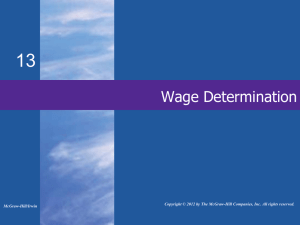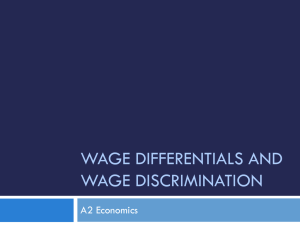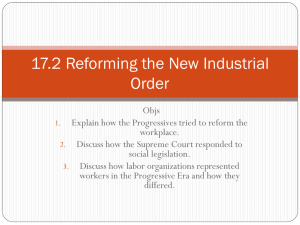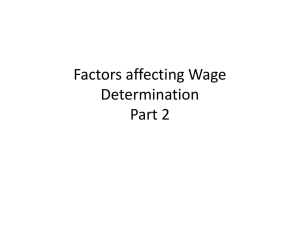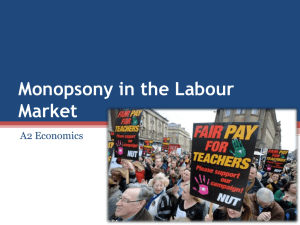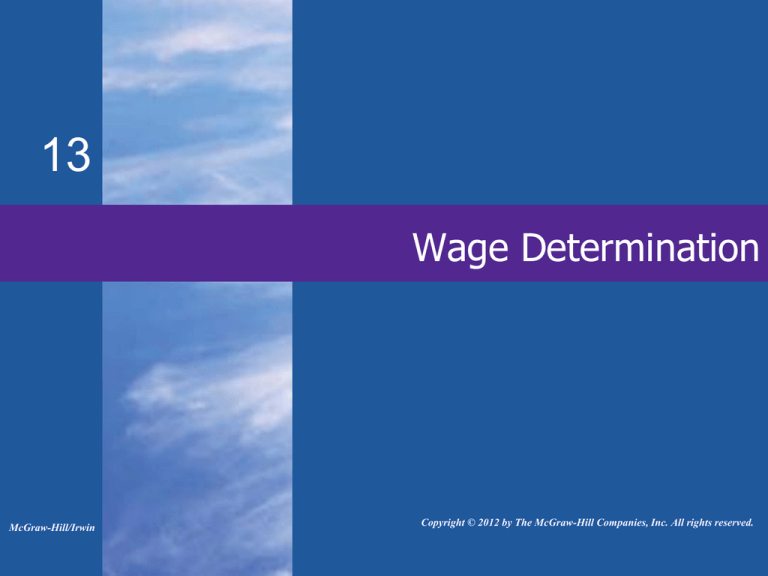
13
Wage Determination
McGraw-Hill/Irwin
Copyright © 2012 by The McGraw-Hill Companies, Inc. All rights reserved.
Labor, Wages ,and Earnings
• Wages
• Price paid for labor
• Direct pay plus fringe benefits
• Wage rate
• Nominal wage
• Real wage
• General level of wages
LO1
13-2
Global Perspective
LO1
13-3
Role of Productivity
• Labor demand depends on
•
LO1
productivity
U.S. labor is highly productive
• Plentiful capital
• Access to abundant natural
resources
• Advanced technology
• Labor quality
• Other factors
13-4
Real Wages and Productivity
• Long-run trend of average real
Real Wage Rate (Dollars)
wages in the U.S.
S2020
S2000
S1900
S1950
D1950
D2000
D2020
D1900
Quantity of Labor
LO1
13-5
Real Wages and Productivity
LO1
13-6
Competitive Labor Market
• Market demand for labor
• Sum of firm demand
• Example: carpenters
• Market supply for labor
• Upward sloping
• Competition among industries
• Labor market equilibrium
• MRP = MRC rule
LO2
13-7
Competitive Labor Market
Labor Market
Individual Firm
a
($10)
WC
($10)
WC
D=MRP
(∑ mrp’s)
0
QC
(1000)
Quantity of Labor
LO2
Wage Rate (Dollars)
Wage Rate (Dollars)
S
0
e
b
c
s=MRC
d=mrp
qC
(5)
Quantity of Labor
13-8
Monopsony Model
• Employer has buying power
• Characteristics
• Single buyer
• Labor immobile
• Firm “wage maker”
• Firm labor supply is upward sloping
• MRC higher than wage rate
• Equilibrium
LO3
13-9
Monopsony Model
• Examples of monopsony power
Wage Rate (Dollars)
MRC
S
b
a
Wc
Wm
c
MRP
0
Qm Q c
Quantity of Labor
LO3
13-10
Monopsony Power
• Maximize profit by hiring smaller
•
•
LO3
number of workers
Examples of monopsony power
• Nurses
• Professional Athletes
• Teachers
Three union models
13-11
Demand Enhancement Model
Wage Rate (Dollars)
• Union model
• Increase product demand
• Alter price of other inputs
S
Increase
In Demand
Wu
Wc
D2
D1
Qc
Qu
Quantity of Labor
LO4
13-12
Craft Union Model
• Effectively reduce supply of labor
• Restrict immigration
• Reduce child labor
• Compulsory retirement
• Shorter workweek
• Exclusive unionism
• Occupational licensing
LO4
13-13
Craft Union Model
Wage Rate (Dollars)
S2
S1
Decrease
In Supply
Wu
Wc
D
Qu
Qc
Quantity of Labor
LO4
13-14
Industrial Union Model
• Inclusive unionism
• Auto and steel workers
Wage Rate (Dollars)
S
Wu
a
b
e
Wc
D
Qu
Qc
Qe
Quantity of Labor
LO4
13-15
Union Models
• Are unions successful?
• Wages 15% higher on average
• Consequences:
• Higher unemployment
• Restricted ability to demand higher
wages
LO4
13-16
Bilateral Monopoly Model
• Monopsony and inclusive unionism
• Single buyer and seller
• Not uncommon
• Indeterminate outcome
• Desirability
LO4
13-17
Bilateral Monopoly Model
Wage Rate (Dollars)
MRC
S
Wu
a
Wc
Wm
D=MRP
Qu=Qm
Qc
Quantity of Labor
LO4
13-18
The Minimum Wage Controversy
• Case against minimum wage
• Case for minimum wage
• State and locally set rates
• Evidence and conclusions
LO5
13-19
Wage Differentials
LO5
13-20
Wage Differentials
W
W
Sa
Sb
Wa
(a)
(b)
Da
Wb
Db
0
Qa
Q
0
Qb
Q
W
W
Sc
(c)
Wc
(d)
Sd
Wd
Dc
0
LO5
Qc
Dd
Q
0
Qd
Q
13-21
Wage Differentials
• Differences across occupations
• What explains wage differentials?
• Marginal revenue productivity
• Noncompeting groups
• Ability
• Education and training
• Compensating differences
LO5
13-22
Wage Differentials
LO5
13-23
Wage Differentials
• Workers prevented from moving to
•
LO5
higher paying jobs
Market imperfections
• Lack of job information
• Geographic immobility
• Unions and government restraints
• Discrimination
13-24
Pay for Performance
• The principal-agent problem
• Incentive pay plan
• Piece rates
• Commissions or royalties
• Bonuses, stock options, and profit
•
LO6
sharing
• Efficiency wages
Negative side-effects
13-25
Are CEOs Overpaid?
• U.S. CEO salaries relatively high
• Good decisions enhance productivity
• Limited supply, high MRP
• Incentive to raise productivity at all
•
•
LO6
levels
High salary bias by board members
Unsettled issue
13-26

